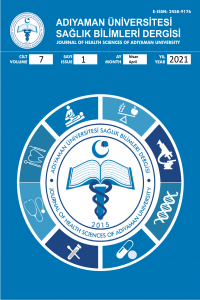Sezaryen sonrası nadir bir postoperatif komplikasyon: Tüberküloz Peritonit; Olgu Sunumu
Giriş: Acil alınan vakalarda daha sık görülse de sezaryen doğumlarda (SD) intraabdominal apse nadir komplikasyonlardandır. Postoperatif karın ağrısı, ateş, halsizlik, kabızlık/ishal, insizyon hattında kızarıklık, pürülan akıntı ve insizyon hattında açılma gibi belirtileri olabilir. Günümüzde pulmoner tüberküloz sıklığı artmaktadır. Bununla birlikte tüberküloz peritonit (TP) gibi ekstrapulmoner tüberküloz nadir görülmektedir. Tam olarak hangi mekanizma ile geliştiği bilinmeyen TP’in, nonspesifik semptomlar nedeniyle tanısı zordur. Tanıda öncelikle hastalığın düşünülmesi önemlidir.Vaka: Beş gün önce Sezaryen Doğum (SD) yapan, sonrasında karın ağrısı, halsizlik şikayetiyle başvuran hastaya postoperatif intraabdominal apse tanısıyla relaparatomi yapıldı. Cerrahi tedaviyi sonrasında uygun antibiyotik tedavisi ile semptomları gerileyen ve kontrol görüntüleme yöntemlerinde intraabdominal patoloji saptanmayan hastada tam klinik iyileşme sağlanamadı. Takibinde pulmoner semptomlarının artması üzerine bronkoskopi yapılan hastaya alınan bronş yıkama sıvısında aside dirençli basillerin görülmesiyle pulmuoner tüberküloz tanısı konuldu. Anti tüberküloz tedavi ile tam klinik iyileşme sağlanan hasta TP olarak kabul edildi. Sonuç: Sıklığı artan TP semptomlarının birçok hastalığı taklit etmesi nedeniyle tanısında zorluklar ve gecikmeler olmaktadır. Özellikle risk faktörü olan bireylerde TP akılda tutulmalı ve nadir de olsa postoperatif dönemde akut batına yol açabileceği düşünülmelidir. Erken teşhis morbidite ve mortaliteyi azaltırken gereksiz cerrahi müdahaleyi engeller.
Anahtar Kelimeler:
Sezaryen doğum, İntraabdominal apse, tüberküloz peritonit
İntroduction: Intraabdominal abscess formation is one of the rare complications observed after cesarean deliveries although it might be observed more commonly during emergency c-sections. The most common signs are postoperative abdominal pain, fever, fatigue, constipation or diarrhea, erythema at the site of the incision, purulent discharge and dehiscence of the incision. Recently, there is an increase in the incidence of tuberculosis. Like this, the incidence of rare forms of extrapulmonary tuberculosis cases like tuberculosis peritonitis are also showing an increase. The mechanism of development of peritoneal tuberculosis is still unclear and its diagnosis is difficult due to nonspecific symptoms. Case: The patient who applied with abdominal pain, fatigue five days after cesarean section had a re-laparotomy with the diagnosis of postoperative intraabdominal abscess formation. The clinical recovery after the second operation was slow although the symptoms regressed with the antibiotic regimen applied postoperatively and no intraabdominal pathology was detected postoperatively with the imaging techniques. The patient was diagnosed to have pulmonary tuberculosis with the detection of acid-resistant bacteria in the bronchoalveolar lavage fluid during the bronchoscopy performed due to the aggravated pulmonary symptoms of the patient during the follow-up period. The patient who had full recovery with the antituberculotic medications had no significant medical history. Result: The diagnosis and treatment of peritoneal tuberculosis is delayed due to its symptoms that mimic other pathologies. This entity must be considered especially in high risk patients and the possibility of development of a postoperative abscess due to it must be kept in mind. Early diagnosis will reduce the morbidity and mortality and prevent unnecessary surgical interventions.
___
- 1. Duff P. Pathophysiology and management of postcesarean endomyometritis. Obstet Gynecol. 1986 Feb;67(2):269-76.
- 2. Duff P. Diagnosis and Management of Postoperative Infection. Glob libr women's med. 2011, ISSN: 1756-2228; DOI 10.3843/GLOWM.10032.
- 3. Delisle M, Seguin J, Zeilinski D, Moore DL. Paediatric abdominal tuberculosis in developed countries: case series and literature review. Arch Dis Child. 2016;101:253-8.
- 4. Marshall JB. Tuberculosis of gastrointestinal tract and peritoneum. Am J Gastroenterol 1993;88:989-99. 5. Dinler G, Sensoy G, Helek D, Kalayci AG. Tuberculous peritonitis in children: report of nine patients and review of the literature. World J Gastroenterol 2008;21: 7235-7239.
- 6. Forssbohm M, Zwahlen M, Loddenkemper R, Rieder HL. Demographic characteristics of patients with extrapulmonary tuberculosis in Germany. Eur Respir J 2008; 31: 99-105.
- 7. Rowińska-Zakrzewska E. Extrapulmonary tuberculosis, risk factors and incidence. Pneumonol Alergol Pol 2011; 79: 377-378.
- 8. Long S, Pickering LK, Prober CG. Principles and Practice of Pediatric Infectious Diseases (4th ed). New York: Elsevier Saunders; 2012.
- 9. Cruz AT, Starke JR. Clinical manifestations of tuberculosis in children. Paediatr Respir Rev 2007;8: 107-117.
- 10. Sanai FM, Bzeizi KI. Systematic review: tuberculous peritonitis-presenting features, diagnostic strategies and treatment. Aliment Pharmacol Ther 2005;22:685-700.
- 11. Rasheed S, Zinicola R, Watson D, et al. Intra-abdominal and gastrointestinal tuberculosis. Colorectal Disease 2007;9:773-83.
- 12. Akhan O, Pringot J. Imaging of abdominal tuberculosis. Eur Radiol 2002;12:312-23. 13. Bhargave DK, Shriniwas, Chopra P. Et al. Peritoneal tuberculosis: laparoscopic patterns and its diagnostic accuracy. Am J Gastroenterol 1992;87:109-12.
- 14. Yancey MK, Clark P, Duff P. The frequency of glove contamination during cesarean delivery. Obstet Gyne¬col 1994;83:538-542.
- 15. Watts DH, Hillier SL, Eschenbach DA. Upper genital tract isolates at delivery as predictors of post-cesar¬ean infections among women receiving antibiotic pro¬phylaxis. Obstet Gynecol 1991;77:287-292.
- 16. Kadanalı A, Karagöz G. Puerperal Infections. Medical Journal of Ümraniye 2012;5;1.
- 17. Uyanıkoğlu H, Uyanıkoğlu A, Büyükfırat E, Gengeç K. Importance of laparoscopic intervention in the differential diagnosis of peritonitis carcinomatosa and tuberculous peritonitis. Turk J Gastroenterol 2017; 28: 528-30.
- 18. Boss JD, Shah CT, Oluwole O, Sheagren JN. TB Mistaken for Ovarian Carcinomatosis Based on an Elevated CA-125. Case Report Med. 2012;2012:215293. Epub 2012 Feb 20.
- Yayın Aralığı: Yılda 3 Sayı
- Başlangıç: 2015
- Yayıncı: ADIYAMAN ÜNİVERSİTESİ
Sayıdaki Diğer Makaleler
Murat Eren ÖZEN, Aysun KALENDEROĞLU, Mustafa ÇELİK, Mehmet Hamdi ÖRÜM, Çiçek HOCAOĞLU
Hayvan Deneyi Çalışmalarında Etik Kuralların Tarihçesi ve Önemi
Yaşlı Hastalarda Uygunsuz İlaç Kullanımının İncelenmesi ve Polifarmasi Varlığı
Erhan BOZKURT, Ali PARLAR, Seyfullah Oktay ARSLAN
HEMŞİRELERİN CERRAHİ HASTASININ BESLENMESİ KONUSUNDA BİLGİ, TUTUM VE UYGULAMALARININ İNCELENMESİ
Mehmet BÜLBÜL, Esra Boyar, İpek Çakılkaya, Selahaddin AKAR, Berna Dilbaz
Hemşirelik Öğrencilerinin Cerrahi Dren Takibi ve Bakımına Yönelik Bilgi Düzeyleri
Akif BULUT, Tuğba AFŞAR, Nursel VATANSEVER
Suna TARKOÇİN, Besime BİLMEZ, Cihangir KAÇMAZ
DİABETİK AYAKTA TEDAVİ YAKLAŞIMLARI VE WAGNER SINIFLAMASININ TEDAVİYİ YÖNLENDİRMEDEKİ ROLÜ
